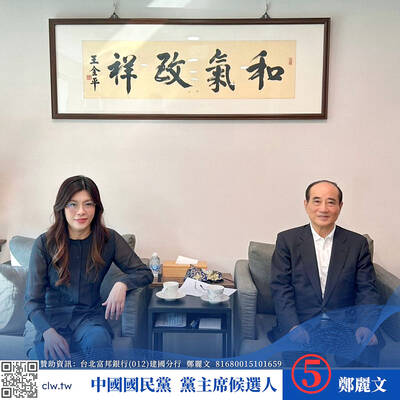The Shanghai Kun Opera Troupe (上海崑劇團) opened its series of three performances at Taipei? Metropolitan Hall (城市舞台) on Friday with an outstanding selection of highlights, including the world premiere presentation of the Farewell at the Waystation (長亭送別) scene from the 13th-century Wang Shi-fu (王實甫) version of the Western Chamber (西廂記). There was plenty of marvel at, and Shanghai Kun Opera Troupe? Yue Meiti (岳美緹), Zhang Jingxian (張靜嫻) and Zhang Mingrong (張銘榮), the three guest performers, garnered rapturous applause from an appreciative audience.
SOUND CHECK?
It was a great pity that, yet again, performers were let down by sound technicians and an inadequate sound system, with microphone crackle occasionally audible beneath a screeching treble that made the high notes almost unbearable at times. One cannot help but wonder why Taiwan, with its world-class expertise in audiovisual technology, cannot manage to set equalizer levels correctly for theatrical performances? The issue remains unacknowledged, and while praise is heaped on performers, the presentation of their work continues to be treated in a slipshod and slapdash way.

PHOTO: COURTESY OF THE TAIWAN KUNQU OPERA THEATER
But this is neither the first nor, unfortunately, the last time that this criticism will be raised. Getting back to the performances themselves, they were uniformly excellent, with local talent from the Taiwan Kunqu Opera Theater (台灣崑曲劇團), which is hosting and providing support for the event, almost holding their own with the visitors. In the first half, the scene Capture Alive (活捉) from the Ming dynasty version of Record of the Water Margin (水滸記) was a tour de force of formal style clowning in which Zhang Mingrong showed off his formidable talent, managing to combine acrobatics, comic stage business and snappy dialog as he attempted to deal with the ghost of a former lover, who ultimately forces him to commit suicide. The mixture of comedy, placed against a background of love, faithlessness, murder and vicious retribution, gave this scene enormous dramatic tension, and though veering into the ostentatious styles more typical of Beijing Opera, certainly livened up the program.
THE GRAND FINALE
The show ran for nearly three-and-a-half hours, and the audience was clearly being given its money? worth, though by the time Farewell at the Waystation, the highlight of the show, was presented, exhaustion had begun to set in. Even so, this famous farewell scene was presented beautifully and was an object lesson in how operatic formalism can achieve remarkable emotional power. The scene, which was arranged for the stage by Yue Meiti specifically for this performance, was lovingly choreographed, but, alas, was also the most disastrously affected by the poor sound.
An older generation of purists might find the selection and its presentation distressingly modern, but the strong ticket sales and a growing proportion of younger people in the audience suggest kun opera is finding success in broadening its appeal.

We lay transfixed under our blankets as the silhouettes of manta rays temporarily eclipsed the moon above us, and flickers of shadow at our feet revealed smaller fish darting in and out of the shelter of the sunken ship. Unwilling to close our eyes against this magnificent spectacle, we continued to watch, oohing and aahing, until the darkness and the exhaustion of the day’s events finally caught up with us and we fell into a deep slumber. Falling asleep under 1.5 million gallons of seawater in relative comfort was undoubtedly the highlight of the weekend, but the rest of the tour

Youngdoung Tenzin is living history of modern Tibet. The Chinese government on Dec. 22 last year sanctioned him along with 19 other Canadians who were associated with the Canada Tibet Committee and the Uighur Rights Advocacy Project. A former political chair of the Canadian Tibetan Association of Ontario and community outreach manager for the Canada Tibet Committee, he is now a lecturer and researcher in Environmental Chemistry at the University of Toronto. “I was born into a nomadic Tibetan family in Tibet,” he says. “I came to India in 1999, when I was 11. I even met [His Holiness] the 14th the Dalai

Following the rollercoaster ride of 2025, next year is already shaping up to be dramatic. The ongoing constitutional crises and the nine-in-one local elections are already dominating the landscape. The constitutional crises are the ones to lose sleep over. Though much business is still being conducted, crucial items such as next year’s budget, civil servant pensions and the proposed eight-year NT$1.25 trillion (approx US$40 billion) special defense budget are still being contested. There are, however, two glimmers of hope. One is that the legally contested move by five of the eight grand justices on the Constitutional Court’s ad hoc move

Stepping off the busy through-road at Yongan Market Station, lights flashing, horns honking, I turn down a small side street and into the warm embrace of my favorite hole-in-the-wall gem, the Hoi An Banh Mi shop (越南會安麵包), red flags and yellow lanterns waving outside. “Little sister, we were wondering where you’ve been, we haven’t seen you in ages!” the owners call out with a smile. It’s been seven days. The restaurant is run by Huang Jin-chuan (黃錦泉), who is married to a local, and her little sister Eva, who helps out on weekends, having also moved to New Taipei